
Trisecting a Line Segment
by: Maggie Hendricks
Trisection Construction #1:
For a GSP script tool of this construction, click here.
To begin this construction, start with a segment AB. Then construct a circle with center A and radius AB as well as a circle with center B and radius AB. Construct ray CA, which is a diamter of circle A. Mark the point where this ray intersects circle A as point D.
Extend AB into a ray and mark the point where this ray intersects circle B as point I. Construct segment DI. Mark the point where DI intersects circle B as point E. Construct the line CE. Mark the point where CE intersects AB as point H.
Claim: AH = 1/3 AB
Note: For the proof of this construction, you will also need to construct a circle with center D and radius AB. Mark its intersection with ray CA as point F. Construct a circle with center F and radius AB. Mark its intersection with line CE as point G. Your resulting figure should look like the diagram below.
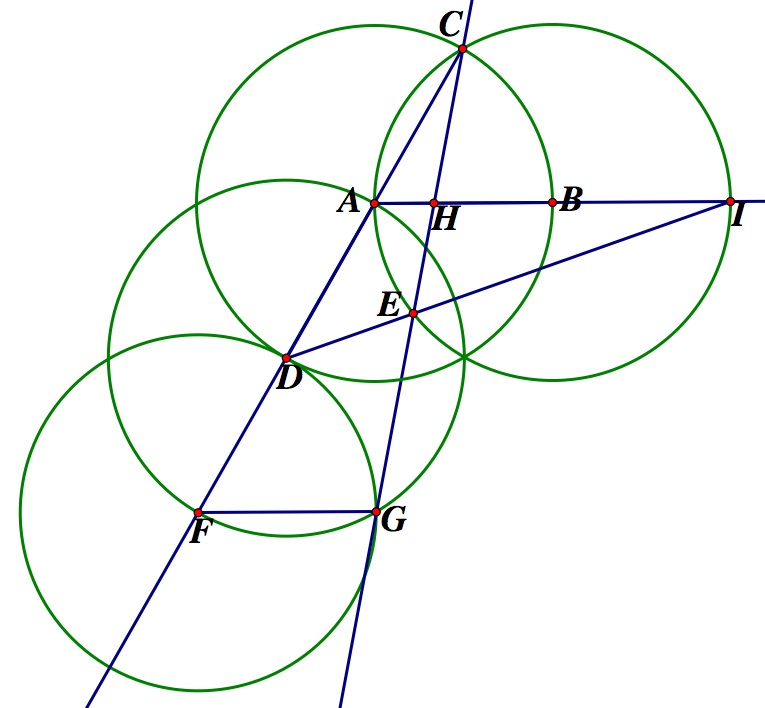
Proof:
Triangle CAB is congruent to triangle DFG (all of the side lengths are congruent radii), so angle CAB = angle DFG. Additionally, angle ACG = angle FCG.
Thus, angle CHA must also equal angle CGF, and triangles CAH and CFG are similar.
Let AB = 1
Then AC = AD = DF = FG = 1 and CF = 3
Since AC = 1, CF = 3, and triangles CAH and CFG are similar, then we know the similarity ratio must be 1/3. Since FG = 1, then we know AH must equal 1/3 and AH is thus equal to 1/3 of AB.
Trisection Construction #2:
For a GSP script tool of this construction, click here. Note: For this construction, you need a line segment AB as well as arbitrary point C in order to get a trisected line segment.
To begin this construction, start with line segment AB and an arbitrary point C. Then construct the line passing through point C and point A. Mark another point on this line and call it D. Construct a circle with center D and radius AD. Mark the point where this circle intersects line CA and call it E. Construct a circle with center E and radius AD. Mark the point where this circle intersects line CA and call it F.
Construct line segment FB, then construct two lines parallel to this segment through points E and D. Mark the point where the line through D intersects segment AB and call it G. Your resulting figure should look similar to the one below.
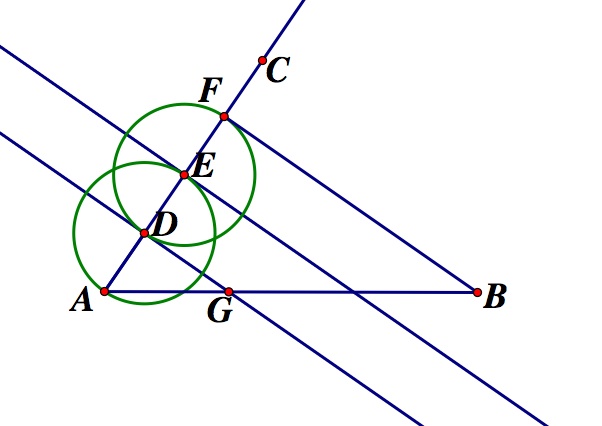
Claim:
AG = 1/3 AB
Proof:
Let AD = 1. Then AD = DE = EF = 1, and AF = 3
Since line DG and FB are parallel, then we can know that triangle FAB is similar to triangle DAG. Since AD = 1 and AF = 3, we know that the ratio of proportionality is 1/3. Thus AG must be 1/3 the length of AB.
Trisection Construction #3:
For a GSP script tool of this construction, click here.
To begin this construction, construct segment AB, a circle with center A and radius AB, and a circle with center B and radius AB. Mark the lower point where these two circles intersect as point C. Construct a circle with center C and radius AB. Construct ray BC and mark the point where it intersects circle C; call it point D. Mark the upper point where circles A and B intersect as point E. Construct line segment DE. Mark the point where this segment intersects AB and call it F.
Claim:
AF = 1/3 AB
Note: For the proof of this construction you will also need to construct the ray EA. Mark the point where this ray intersects circle A as point G. Construct circles with centers G and D with radius AB. Mark the point where these two circles intersect as point H.
Your resulting figure should look similar to the diagram below.
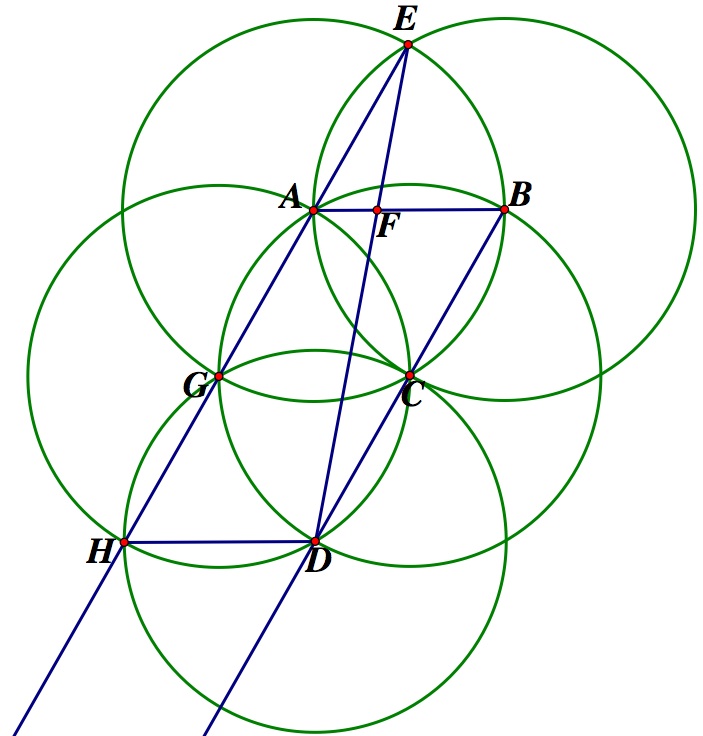
Proof:
Let AB = 1
Then AB = AE = AG = GH = HD = 1, and EH = 3
Since triangles EAB and GHD are equilateral (the side lengths are all congruent radii), then angle EAB is congruent to angle GHD. Note also that angle AEF is conrguent to angle HED. Thus, angle EFA must also be conrguent to angle EDH, and triangle EAF and EHD are similar. Since AE = 1, AND EH = 3, we know the ratio of proportionality between these two triangles is 1/3. Side AF must be similar to side HD, and since HD = 1, AF = 1/3. Thus, AF is equal to 1/3 of AB.
Trisection Construction #4:
For a GSP script tool of this construction, click here.
To begin this construction, start with line segment AB. Construct a circle with center A and radius AB. Then, take the diameter of circle A and construct a circle with center B and radius of this diameter length. Extend segment AB so it forms a line. Mark the point where circle B intersects line AB and call it C. Construct a circle with center C and radius AC. Mark the point where circle C and circle A intersect; call it D. Construct a circle with center D and radius AB. Mark the point where circle D intersects segment AB and call it E.
Claim: AE = 1/3 AB
Note: For this construction, you will also need to construct a line perpendicular to AB through point D. Mark the intersection of this line with AB and call it point F.
Your resulting figure should look similar to the diagram below.
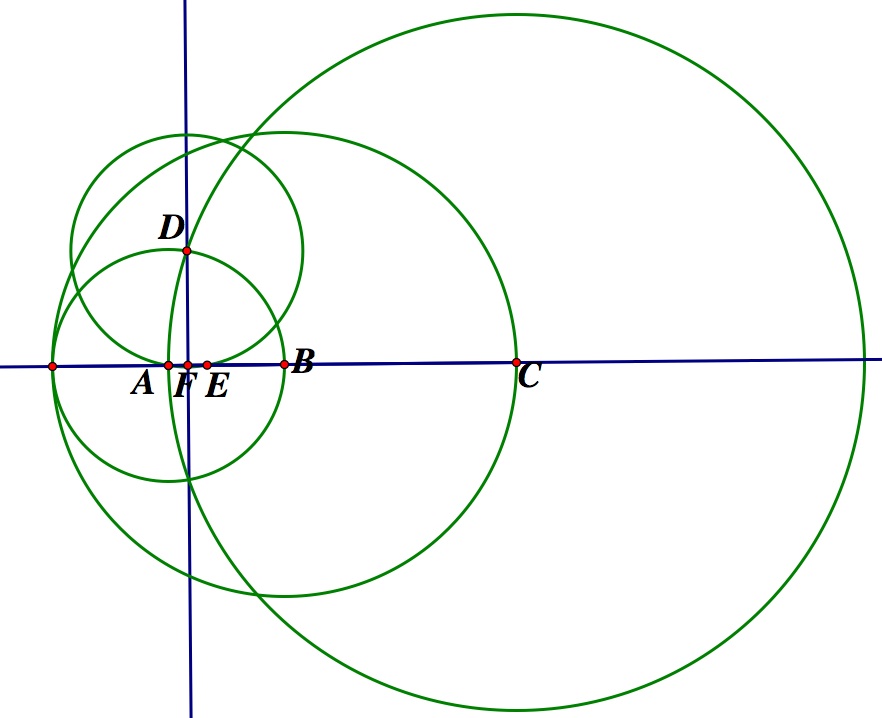
Proof:
Note that angle ADC is a right angle (since it is an inscribed angle to the diameter of circle C). Angle DFA is also a right angle (by construction). Also notice that angle DAF is congruent to angle DAG. Thus, angle ADF must also be congruent to angle DGA, and triangles DAF and GAD are similar.
Let AB = 1
Then AD is also equal to 1. Line segment AG is equal to 6 (by construction). AD and AG are corresponding segments in similar triangles, and so we can know the ratio of proportionality between them is 1/6. We also know that AD and AF are corresponding segments in similar triangles with a ratio of 1/6, so AF must equal 1/6. Point F bisects segment AE (since triangle DAE is an isosceles triangle). Thus, AE = 2 AF and so AE = 1/3, which shows that it is a trisection of segment AB.
Trisection Construction #5:
For a GSP script tool of this construction, click here.
To begin with this construction, start with line segment AB and construct an arbitrary point C. Construct a circle with center C and radius AC. Extend AC into a ray and mark the point where circle C intersects it as point D.
Construct a line parallel to AC through point B. Construct a circle with center B and radius AC. Mark the point where this circle intersects the line through point B and call it E. Now construct a circle with center E and radius AC. Mark the point where it intersects the line through B and call it F.
Now construct line segments DE and CF. Mark the point where CF intersects AB and call it G. Your resulting figure should look similar to the one below.
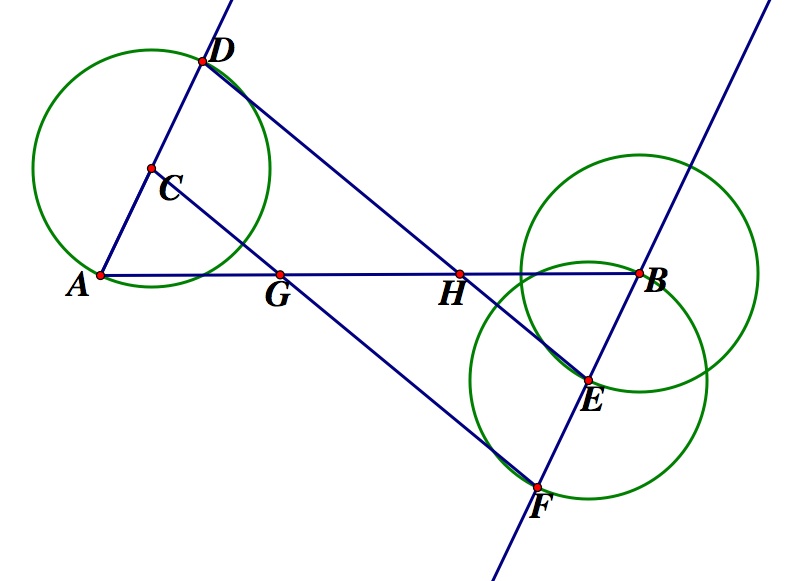
Claim:
AG = 1/3 AB
Proof:
By construction, we know AC = CD = BE = EF and AD = BF. Thus, angle G and angle H must be conrguent, and line CF and DE must be parallel.
From here, we can say that trianges ACG and ADH must be similar, and we can know the ratio of proportionality is 1/2 (since AC = 1/2 AD). This tells us that AG = 1/2 AH, and GH = 1/2 AH.
We also know that triangles BHE and BGF are similar, and the ratio of proportionality is 1/2 (since BE = 1/2 BF). This tells us that BH = 1/2 BG, and GH = 1/2 BG.
Therefore, AG = GH = HB. We also know that AG+GH+HB = AB, so we can say that AG = 1/3 AB, and we have shown that AG is a trisection of segment AB.
Trisection Construction #6:
For a GSP script tool of this construction, click here.
To begin this construction, begin with segment AB and construct circles with centers A and B and with radius AB. Mark the point where these two circles intersect at the top as C. Construct the line through points A and C. Mark the point where this line intersects circle A and call it E. Construct segment BE and BC. Construct the midpoint of segment AB and call it F. Construct the segment CF and mark the intersection of it with AB as point G.
Your resulting figure should look similar to the diagram below.
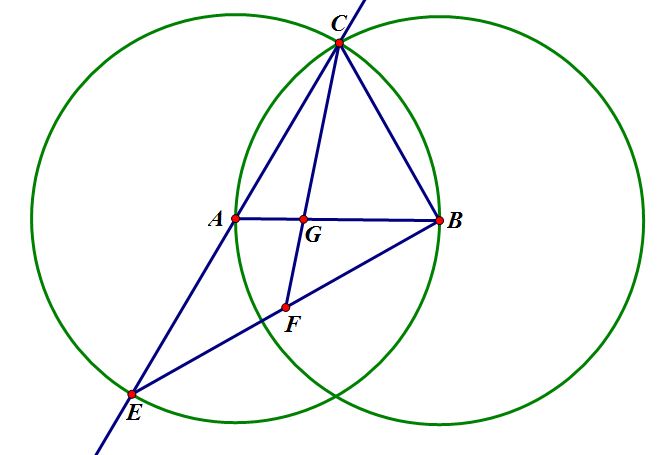
Claim:
AG = 1/3 AB
Proof:
Segments AB and CF are medians of triangle BCE (by construction). The point where these medians intersect is the centroid of that triangle. One property of the centroid of a triangle is that it splits its medians into a ratio of 1:2, meaning segment AG is equal to half the length of segment GB. We could also say it this way:
GB = 2(AG) and AB = AG + GB, so AB = AG+AG+AG or AB = 3(AG) and so AG = 1/3 AB.
Click here to return to Maggie's homepage.

